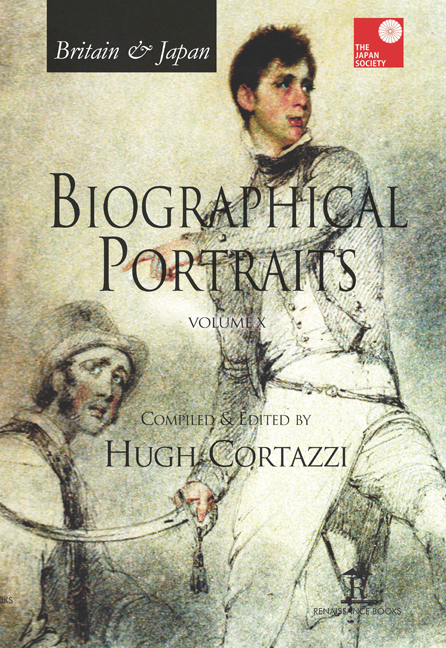Book contents
- Frontmatter
- Dedication
- Contents
- Introduction
- List of Contributors
- Index of Biographical Portraits in Japan Society Volumes
- PART I BRITAIN IN JAPAN
- PART II JAPAN IN BRITAIN
- Select Bibliography of Works in English on Anglo-Japanese Relations [Compiled by Gill Goddard – Retired East Asian Studies Librarian, University of Sheffield]
- Select Bibliography of Works in Japanese on Anglo-Japanese Relations [Compiled by Akira Hirano, SISJAC]
- Index
68 - Lisa, Lady Sainsbury (1912–2014): Bringing Japanese Art to East Anglia
Published online by Cambridge University Press: 07 May 2022
- Frontmatter
- Dedication
- Contents
- Introduction
- List of Contributors
- Index of Biographical Portraits in Japan Society Volumes
- PART I BRITAIN IN JAPAN
- PART II JAPAN IN BRITAIN
- Select Bibliography of Works in English on Anglo-Japanese Relations [Compiled by Gill Goddard – Retired East Asian Studies Librarian, University of Sheffield]
- Select Bibliography of Works in Japanese on Anglo-Japanese Relations [Compiled by Akira Hirano, SISJAC]
- Index
Summary
LISA SAINSBURY IS remembered as a remarkable woman with a quick discerning mind and broad vision. Her interests spanned from health, public service, education and botany to the arts. Her attention was always focused on the human interface in those areas. She and her husband Sir Robert were pioneers in many fields, from commissioning the then little known architect Norman Foster to building a gallery and teaching space at the new University of East Anglia, to funding a computerized system of plant management at Kew Gardens. Lady Sainsbury is deservedly well known as a patron of artists and of twentieth-century arts, but her deep interest in and strategic support for Japanese arts and the study of Japanese arts has received less attention.
Lisa Ingeborg Van den Bergh was born in 1912 and brought up between London, Paris and Geneva. The original fortune of the Dutch family was made from the manufacture of margarine. Her father, Simon Van den Burgh, was at the time of her birth a professor of philosophy at the University of Paris and as a consequence, Lisa grew up speaking Dutch, French and English allequally comfortably. While she had a privileged upbringing, her original wish of becoming a doctor was thwarted by her parents who felt that it was not a suitable profession for her, a common social prejudice of the times. Instead, she pursued nursing and kept a life-long passion for the health profession and in particular for patient and end-of-life care, funding hospices such as St Christopher’s.
Lisa was more fortunate in her marriage to Robert (Bob) Sainsbury (1906–2000), the heir to the grocery fortune founded by Sir Robert's grandfather John Sainsbury (1844–1928). Bob was her second cousin and in him she found a true kindred spirit. Ever practical, they married in a London registry office in 1937. Of that marriage it could be truly said ‘they lived happily ever after’ until the death of Robert in 2000. In all things artistic, cultural and philanthropic, Bob and Lisa Sainsbury worked as a team, balancing each other and making decisions together.
Soon after their marriage Lisa and Bob moved into No. 5 Smith’s Square, Westminster living there until 1994. Lisa then suggested they move away to The Grange, Dulwich Village, where they were surrounded by a magnificent garden and their most recent purchases. Lisa remained at The Grange until her death twenty years later.
- Type
- Chapter
- Information
- Britain & Japan Biographical Portraits Vol X , pp. 773 - 778Publisher: Amsterdam University PressPrint publication year: 2016



